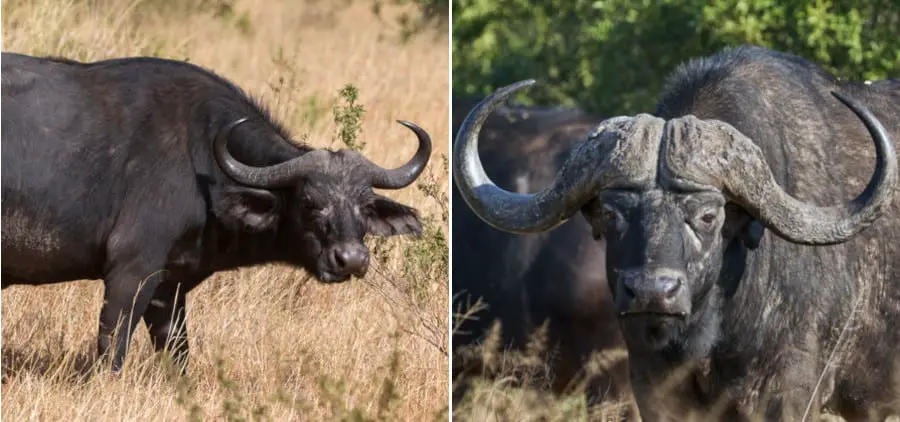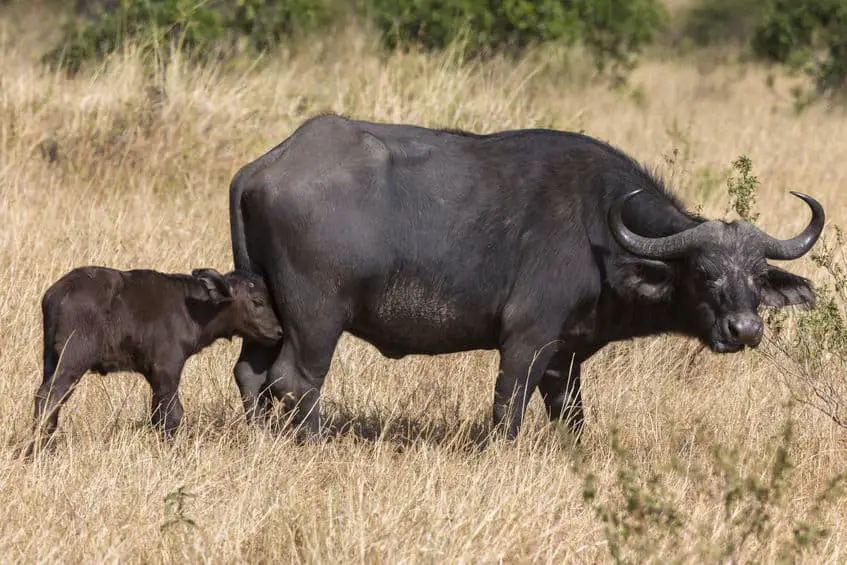
Male and female Cape buffalos are often described as being almost identical and not having many differences, but there are actually some quite significant differences between them that are often overlooked.
Indeed, it is not always as easy to tell male and female Cape buffalos apart as it is with other animals but there are some differences in both their appearance and their behavior that make them both stand out from each other.
In this post, I have covered what I find to be the 11 most significant and distinguishable differences between male and female Cape buffalos. Some of the differences I have covered in this post are found in the appearance and some of the differences are found in the behavior of male and female Cape buffalos.
At birth and for the first two years of the calves’ lives, male and female Cape buffalos are almost identical and indistinguishable from each other but around this age, some of the visible differences between them will start to develop.
1. Males Are Darker Than Females
When they are young, the color of male and female Cape buffalos is usually very similar but when they grow older, this starts to change.
Grown female Cape buffalos (called cows) tend to be brown, sometimes with a slight red tint whereas the males (called bulls) are darker brown and become almost charcoal-colored or even black when they are old.
2. Males are Much Larger Than Females
There is also a quite significant difference in the size of male and female Cape buffalos.
Male Cape buffalos can get quite a bit larger than their female counterparts and they differ from each other especially when it comes to their weight.
The largest Cape buffalo males weigh upwards of 2000 pounds (around 900 kg) and the largest females can weigh 1365 pounds (around 620 kg).
The size of Cape buffalos can differ quite a bit from region to region, however, and for fully grown male Cape buffalos it can range from 1100 to 2000 pounds (500 to 900 kg) and 770 to 1365 pounds (350 to 620 kg) for fully grown females.
Cape buffalos are not only very heavy creatures but they also stand quite tall. The males can reach up to 5.75 feet (175 cm) in height and the females a bit less at 4.9 feet (150 cm).
3. Males Have Thicker Necks and Shoulders
Male Cape buffalos develop thicker necks than females. They also have a large hump over their shoulders just past their necks which the females do not.
The males also often have a dewlap with some long hairs around their throats which the females do not.
4. Males Have Thicker Horns That Form a Defensive Shield Called a Boss

Perhaps the most well-known difference between male and female Cape buffalos and one of the easiest ways to tell them apart is the way the horns look, but there is actually a very good reason why their horns are different.
Both male and female Cape buffalos have large, strong horns which they use for various purposes such as defending themselves and the rest of their herd and fighting among each other to establish dominance (just the males do this).
When they are young, it is difficult to tell male and female Cape buffalos apart by looking at their horns but as they grow older, the difference in the way their horns look will become more apparent.
The horns on both males and females have a curved shape that almost looks like two hooks pointing in opposite directions. The horns on the females will grow to become longer and more slender than the males’ horns which will generally become a bit shorter but thicker.
It takes slightly longer for males’ horns to reach their full size than it does for the females’ horns. It takes around 5 years for the males’ horns and 4 years for the females’ horns.
As the young males’ horns grow, they will start to thicken and eventually meet at the middle and form a thick, rock-solid, protective area that covers the forehead and works almost like a thick helmet or a shield. This area is called a boss.
The longest Cape buffalo horn ever on record measured a stunning 5.35 feet (163 cm) round the curve from base to tip. This impressive record belongs to a female.
The males’ horns will also often tell you quite a bit about each male and their place in the hierarchy. The larger and thicker a male Cape buffalos’ horns are, the higher in the hierarchy that male will generally be.
Both male and female Cape buffalos use their horns to defend themselves, their calves, and the rest of their herd from large predators such as hyenas and lions. Especially lions are one of the only, and primary natural enemies for Cape buffalos and when these two large and confrontational animals meet, things can get fierce very quickly.
If you are interested in learning more about the age-old rivalry between Cape buffalos and lions, I highly recommend taking a look at this post which goes into much greater detail about it.
In this incredible footage rightfully and appropriately named Battle at Kruger, you can see just how fierce and brutal things can get when Cape buffalos and lions meet.
But Cape buffalos do not only use their horns to fight off dangerous predators. They also serve as an important tool for male Cape buffalos when it comes to establishing dominance in the herd.
5. Males Fight Each Other to Establish Dominance
It is not uncommon for the males of certain species of animals to try to establish dominance over each other by either fighting individually or trying to intimidate other males otherwise
Cape buffalos are no different when it comes to this and fights among males are not an uncommon occurrence. They mostly do this to establish dominance since the dominant male(s) of a herd will generally be more attractive to the females and therefore get to choose which of them they want to mate with
When trying to establish dominance and secure their place in the hierarchy, the two competing males will circle each other and attempt to push each other using their horns and boss to try to intimidate their opponent. If none of the two Cape buffalos are intimidated by the other after a couple of minutes, they will have to determine who is the winner in a different way.
The two competing males will try to determine which of them is stronger by pushing each other using their horns and the boss on their forehead to make the other one fall over or forfeit. If this is not enough and neither of them forfeits, they will back up until they are around 50 to 100 feet from each other (15 to 30 meters) after which they will charge head-first towards each other at full speed banging their horns and bosses against each other.
These clashes can be so intense and powerful that the weaker male can sometimes get tossed through the air which takes an incredible amount of force and strength since Cape buffalos are very large and heavy animals.
The sound from these clashes is so loud that it can be heard far away.
The winner of this fight will be perceived as being the dominant of the two competitors by the rest of the herd and will have a higher place in the herd hierarchy meaning that the females will generally be more attracted to him.
6. Males and Females Have Different Places in the Herd

Herds of Cape buffalos consist of both females, calves, and males. Like in some other species of large African mammals such as elephants, the females are in many ways the core of the herd.
A herd of Cape buffalos consists of a group of females that are all related to each other, their calves, and a smaller group of males that are not related to them, following them from a short distance.
These herds usually consist of 15 to 20 animals with the majority of them being females but sometimes the herds can consist of several hundred or even thousands of Cape buffalos.
Sometimes Cape buffalo males can also stay in small bachelor herds consisting of just a couple of males and sometimes they even become solitary and live on their own and will sometimes only seek out females during mating season.
Older males that can no longer produce offspring will often wander off from their herd and either stay by themselves or seek out other older males and form small herds consisting of just those older males. These older males will typically stick to a small territory.
One of the most memorable experiences I have ever personally had with Cape buffalos was when my family and I stayed for a couple of days at Biyamiti Bushveld Camp in the southern part of the Kruger National Park of South Africa. From the outdoor areas of that rest camp, you can have an amazing view of a long and wide, mostly dried out river that continues for many miles and eventually becomes a river full of life known as Crocodile River which runs all the way far into southern Mozambique.
One evening after a great day of solo game drives, we sat down at a bench at the rest camp from which we had a nice view of the mostly dried out river, and at some point out of nowhere, we could literally hear the ground rumble and not long thereafter we saw a massive herd of thousands of Cape buffalos who chose the dried out parts of the riverbed for one of their long walks since the wide, open area provides more safety and is more easily accessible to the large numbers of Cape buffalos. We literally just sat there in awe and watched the massive herd walk by us on the other side of the rest camps’ fence. This was truly an incredible sight that I will never forget.
You never really know when you will have these amazing sights when you’re on a safari and they often come when you least expect them, so I highly recommend getting a good pair of binoculars and perhaps a camera to be well prepared for it. I have written two posts describing everything you need to know when picking a pair of binoculars and a camera, including specs, adjustments, and a couple of specific suggestions for different budgets. You can find the post about binoculars on this link and cameras on this link.
These herds of several thousand Cape buffalos are more common in some parts of Africa than others but are generally temporary and mostly occur during mating season or for long walks which is what my family and I witnessed in Kruger.
During the dry season, these massive herds will usually split up as it can become difficult to find food sources bountiful enough to feed thousands of animals at the same time.
7. Females Decide Where the Herd Goes
Being at the core of the herd, the female Cape buffalos also seem to be the ones who decide which direction the herd is moving in.
The males will generally stay a bit further back from the females and follow them.
8. Females Raise the Calves

Like many other animals, there is also a quite significant difference between male and female Cape buffalos when it comes to raising their offspring.
The females will take good, extensive care of the offspring and raise them in the herds whereas the males will not participate and rarely even invest any time or energy in the calves.
9. Females May Adopt Calves Who Lost Their Mother
Unfortunately it is not very uncommon for Cape buffalo calves to lose their mother.
Sometimes when a calf has either lost its mother to disease or predators or if the mother has simply abandoned it, it will seek out other calves that are in the same situation to increase their safety and essentially their chance of surviving.
The group of Cape buffalo calves will seek out an older female in the hope for them to take pity on the calves and take care of them. The females that choose to adopt and raise these abandoned calves will usually be older females without calves of their own.
These older females can sometimes adopt up to around five abandoned calves.
10. Males Are at Higher Risk of Being Hunted by Predators
The biggest threat and most common killer among Cape buffalos is without a doubt disease. Cape buffalos often stay in large and dense herds which can cause the potential spreading of a disease to be both quick and reach many animals.
While they do increase the risk of spreading diseases, the large herds that Cape buffalos usually stay in do provide increased protection from natural predators such as hyenas or lions since Cape buffalos are great at defending each other and will usually all attack if one of the members of the herd is under attack from predators.
For this reason, large predators will often try to seek out Cape buffalos that have either been isolated from the rest of their herd or simply just live on their own, since these are easier to hunt and since male Cape buffalos are more likely to live on their own than females, the risk of becoming the target of a group of predators is higher for them.
On their own, neither lions nor hyenas are able to overpower a healthy and fully grown Cape buffalo but since both lions and hyenas usually hunt as groups (called prides and cackles respectively), they are often able to take down a single Cape buffalo.
Cape buffalos and lions are a big threat to each other and the outcome of a fight between them can be in favor of either of them.
11. Males Spend Large Amounts of Time Rolling in Mud
Cape buffalos like to roll around in mud and often spend large amounts of time doing so.
Especially the males tend to cover themselves in mud as it will give them a darker, almost black color when the mud dries.
A darker color signals masculinity and dominance for Cape buffalos and sometimes the stronger, dominant males will claim pools of mud and prevent weaker males from also covering themselves in the mud.
Old Cape buffalo males also become almost black, displaying their masculinity.
